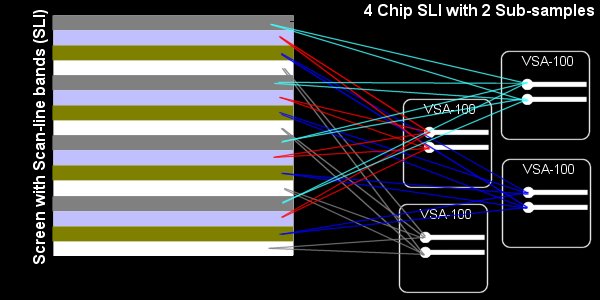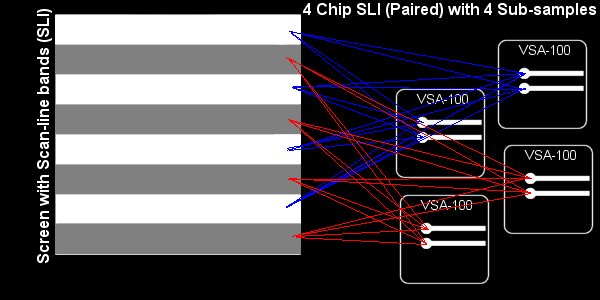
Now, what about 4 chips using 4 sub-samples. Well, this is where it gets interesting. Here, you could almost say that the chips work in groups of 2, with each group acting as though it were a single chip. What happens is the screen is SLIed similar to a 2-chip solution. Now, each group of two renders every other set of bands. So, in each band one chip renders 2 sub-samples and the other chip renders 2 sub-samples. Here, your performance can be expected to be about that of a single chip, or 2-pixels/clock. Here, again, we have another situation where we are holding 4X the frame-buffer data. Each chip would normally hold 2X the data because each renders 2 sub-samples. Now, we have the chips in groups of 2s, so for each group 4X the data is held. Now, because the chips are paired and SLIed, the amount of data held is cut in half. This, basically, means that each pair is holding twice the data, or a combined total of 4X the normal data held.

So, how will you use it yourself? Well, 3dfx is planning on giving the user the option to decide which setting to use and this will be used a on per-game basis. A lot also depends on if a game is fill-rate of CPU limited. If you're playing something like Falcon 4.0, you might be just fine rendering 4 sub-samples on a 2-chip board because you're so CPU limited, where as if you were playing Quake III, you might not want to use any anti-aliasing at all. It is really a personal choice that each user will make. What frame-rate is fast enough for a given game for you? If you demand the absolute highest frame-rate, you won't use any AA at all, where as if you're fine in the 40-50 fps area, you might use 4X AA on a 4-chip board. Again, it is a very personal choice.
Stay tuned for Part 3 in which we'll look some more at the T-buffer and the whole T-buffer vs. T&L issue.
